Feature-Based Characterisation of Turned Surface Topography with Suppression of High-Frequency Measurement Errors
Abstract
1. Introduction
2. Materials and Methods
2.1. Analysed Surfaces
2.2. Measurement Process
2.3. Applied Methods
3. Results and Discussion
3.1. Comparison of Regular and Feature-Based Methods for a High-Frequency Noise Detection
3.2. Selection of Cut-Off Value with a Feature-Based Technique
4. The Outlook
- Feature-based characterisation for the suppression of high-frequency measurement noise cannot be validated for isotropic surfaces where the properties of NSs (such as defining features and texture direction) are difficult to be determined. In this case, it is difficult to find any features on the NSs even though a relatively huge (e.g., 0.035 mm) filter bandwidth is proposed. Increasing the bandwidth would remove essential features in the roughness evaluation process.
- The proposed technique was not convincing when the surface contained relatively shallow features, such as holes, dimples, and oil pockets. In this case, the detection of non-noise features on the NS can be difficult. However, the parameters (size, depth, width, and density) of features would depend on the surface height (both Sa and Sz values).
- For isotropic surfaces, the definition of the cut-off value can be even more complicated than increasing the bandwidth value, e.g., from 0.025 mm to 0.35 mm, and may not allow for the detection of unwanted features on the NS. Moreover, the selection of a proper filter would also be difficult. Increasing bandwidth can cause more distortions in surface features, especially wide and deep dimples (valleys). For that matter, analysis of the ACF shape and TD graph may be reasonably required.
- A feature-based method can be applied to many other types of surface texture where direction can be defined, such as plateau-honed cylinder liner topographies, ground, milled, and laser-textured, with a defined direction of features in general. However, when selecting the algorithm (e.g., filter) and, especially, its bandwidth value, different features with various locations and densities must be characterised. The distortion of results received by digital filtering can arise when certain inappropriate methods (filters) are applied.
5. Conclusions
- High-frequency measurement noise can affect the results of surface topography analysis, especially when considering the ISO 25178 parameters. The whole reduction process of this type of error can be divided into two separate but tightly connected processes: detection (definition) and removal (reduction).
- For the detection of high-frequency errors in surface metrology, it is suggested to use a multithreaded technique, where various analysis methods are applied simultaneously. In the validity of the detection process, many regular techniques available in commercial software are sufficient, e.g., PSD, ACF, and TD techniques. The application of those commonly available methods can improve the detection process significantly.
- Feature-based techniques can be especially valuable in improving the detection and reduction processes of high-frequency measurement noise that can help better validate NS properties. The definition of NSs with required characteristics can reduce the errors in high-frequency measurement noise reduction.
- When selecting the bandwidth value of digital filtering to suppress high-frequency measurement errors, all of the techniques, feature-based, PSD, ACF, and TD, must be provided simultaneously. It is suggested to increase the value of the cut-off until the NS contains non-high-frequency-noise features, such as dimples, holes, scratches, etc. When NSs contain unwanted features, the value of the filter bandwidth must be decreased.
- It was observed that the selection of filter bandwidth depends on the size and density of the features in surface texture. However, the smaller the number of features on the raw measured data detected, the more attention must be paid when selecting the method (filter) and its bandwidth (cut-off) value. The occurrence of the surface features is crucial in the detection and reduction of considered high-frequency measurement errors, so any feature-based technique can be highly advantageous in roughness evaluation and the calculation of ISO 25178 surface topography parameters.
Funding
Institutional Review Board Statement
Informed Consent Statement
Data Availability Statement
Conflicts of Interest
Nomenclature
| ACF | autocorrelation function |
| FFT | fast Fourier transform |
| FFTF | fast Fourier transform filter |
| GF | regular Gaussian regression filter |
| NS | noise surface |
| PSD | power spectral density |
| RGF | robust Gaussian regression filter |
| SF | regular isotropic spline filter |
| TD | texture direction (graph) |
| Sa | arithmetic mean height Sa, µm |
| Sal | auto-correlation length, mm |
| Sbi | surface bearing index |
| Sci | core fluid retention index |
| Sdq | root mean square gradient |
| Sdr | developed interfacial areal ratio, % |
| Sk | core roughness depth, µm |
| Sku | kurtosis |
| Smc | inverse areal material ratio |
| Smr | areal material ratio |
| Sp | maximum peak height, µm |
| Spc | arithmetic mean peak curvature, 1/mm |
| Spd | peak density, 1/mm2 |
| Spk | reduced summit height, µm |
| Sq | root mean square height, µm |
| Ssk | skewness |
| Std | texture direction, ° |
| Str | texture parameter |
| Sv | maximum valley depth, µm |
| Svi | valley fluid retention index |
| Svk | reduced valley depth, µm |
| Sxp | extreme peak height |
| Sz | the maximum height of surface, µm |
References
- Ohlsson, R.; Wihlborg, A.; Westberg, H. The accuracy of fast 3D topography measurements. Int. J. Mach. Tools Manuf. 2001, 41, 1899–1907. [Google Scholar] [CrossRef]
- Vorburger, T.V.; Rhee, H.-G.; Renegar, T.B.; Song, J.-F.; Zheng, A. Comparison of optical and stylus methods for measurement of surface texture. Int. J. Adv. Manuf. Technol. 2007, 33, 110–118. [Google Scholar] [CrossRef]
- Pawlus, P.; Wieczorowski, M.; Mathia, T. The Errors of Stylus Methods in Surface Topography Measurements; Zapol: Szczecin, Poland, 2014. [Google Scholar]
- Podulka, P. Bisquare robust polynomial fitting method for dimple distortion minimization in surface quality analysis. Surf. Interface Anal. 2020, 52, 875–881. [Google Scholar] [CrossRef]
- Podulka, P. The effect of valley depth on areal form removal in surface topography measurements. Bull. Pol. Acad. Sci. Tech. Sci. 2019, 67, 391–400. [Google Scholar] [CrossRef]
- Leach, R.; Evans, C.; He, L.; Davies, A.; Duparré, A.; Henning, A.; Jones, C.W.; O’Connor, D. Open questions in surface topography measurement: A roadmap. Surf. Topogr. Metrol. Prop. 2015, 3, 13001. [Google Scholar] [CrossRef]
- Miao, J.; Yu, D.; An, C.; Ye, F.; Yao, J. Investigation on the generation of the medium-frequency waviness error in flycutting based on 3D surface topography. Int. J. Adv. Manuf. Technol. 2016, 90, 667–675. [Google Scholar] [CrossRef]
- Lédl, V.; Psota, P.; Kaván, F.; Matoušek, O.; Mokrý, P. Surface topography measurement by frequency sweeping digital holography. Appl. Opt. 2017, 56, 7808–7814. [Google Scholar] [CrossRef]
- ISO WD 25178-600:2014(E); Geometrical Product Specifications (GPS)—Surface Texture: Areal—Part 600: Metrological Characteristics for Areal-Topography Measuring Methods (DRAFT). International Organization for Standardization: Geneva, Switzerland, 2014.
- Vanrusselt, M.; Haitjema, H.; Leach, R.K.; de Groot, P. International comparison of noise in areal surface topography measurements. Surf. Topogr. Metrol. Prop. 2021, 9, 025015. [Google Scholar] [CrossRef]
- Jacobs, T.D.B.; Junge, T.; Pastewka, L. Quantitative characterization of surface topography using spectral analysis. Surf. Topogr. Metrol. Prop. 2017, 5, 013001. [Google Scholar] [CrossRef]
- De Groot, P.; DiSciacca, J. Definition and evaluation of topography measurement noise in optical instruments. Opt. Eng. 2020, 59, 064110. [Google Scholar] [CrossRef]
- Servin, M.; Estrada, J.C.; Quiroga, J.A.; Mosiño, J.F.; Cywiak, M. Noise in phase shifting interferometry. Opt. Express 2009, 17, 8789–8794. [Google Scholar] [CrossRef] [PubMed]
- Šarbort, M.; Holá, M.; Pavelka, J.; Schovánek, P.; Rerucha, Š.; Oulehla, J.; Fořt, T.; Lazar, J. Comparison of three focus sensors for optical topography measurement of rough surfaces. Opt. Express 2019, 27, 33459. [Google Scholar] [CrossRef] [PubMed]
- de Groot, P.J. The instrument transfer function for optical measurements of surface topography. J. Phys. Photon. 2021, 3, 024004. [Google Scholar] [CrossRef]
- Podulka, P. Selection of methods of surface texture characterisation for reduction of the frequency-based errors in the measurement and data analysis processes. Sensors 2022, 22, 791. [Google Scholar] [CrossRef]
- Guo, M.-X.; Liu, J.; Pan, L.-M.; Wu, C.-J.; Jiang, X.-H.; Guo, W.-C. An integrated machine-process-controller model to predict milling surface topography considering vibration suppression. Adv. Manuf. 2020, 10, 443–458. [Google Scholar] [CrossRef]
- Cao, Y.; Guan, J.; Li, B.; Chen, X.; Yang, J.; Gan, C. Modeling and simulation of grinding surface topography considering wheel vibration. Int. J. Adv. Manuf. Technol. 2013, 66, 937–945. [Google Scholar] [CrossRef]
- He, B.; Zheng, H.; Ding, S.; Yang, R.; Shi, Z. A review of digital filtering in evaluation of surface roughness. Metrol. Meas. Syst. 2021, 28, 217–253. [Google Scholar] [CrossRef]
- Gurau, L.; Irle, M. Surface roughness evaluation methods for wood products: A review. Curr. For. Rep. 2017, 3, 119–131. [Google Scholar] [CrossRef]
- Jiang, X.J.; Whitehouse, D.J. Technological shifts in surface metrology. CIRP Ann. 2012, 61, 815–836. [Google Scholar] [CrossRef]
- Xia, C.; Li, H.; Zhang, J.; Zhang, X.; Jia, S. Gaussian filtering algorithm describing the topography of temper rolled strip and related edge effect. Mater. Test. 2018, 60, 61–67. [Google Scholar] [CrossRef]
- ISO 16610-21; Geometrical Product Specifications (GPS)—Filtration—Part 21: Linear Profile Filters: Gaussian Filters. International Organization for Standardization: Geneva, Switzerland, 2011.
- Janecki, D. Edge effect elimination in the recursive implementation of Gaussian filters. Precis. Eng. 2012, 36, 128–136. [Google Scholar] [CrossRef]
- Lou, S.; Jiang, X.; Sun, W.; Zeng, W.; Pagani, L.; Scott, P.J. Characterisation methods for powder bed fusion processed surface topography. Precis. Eng. 2019, 57, 1–15. [Google Scholar] [CrossRef]
- ISO 16610-31; Geometrical Product Specifications (GPS)—Filtration—Part 31: Robust Profile Filters: Gaussian Regression Filters. International Organization for Standardization: Geneva, Switzerland, 2016.
- Podulka, P. Suppression of the high-frequency errors in surface topography measurements based on comparison of various spline filtering methods. Materials 2021, 14, 5096. [Google Scholar] [CrossRef]
- Zeng, W.; Jiang, X.; Scott, P. A generalised linear and nonlinear spline filter. Wear 2011, 271, 544–547. [Google Scholar] [CrossRef][Green Version]
- Tong, M.; Zhang, H.; Ott, D.; Chu, W.; Song, J. Applications of the spline filter for areal filtration. Meas. Sci. Technol. 2015, 26, 127002. [Google Scholar] [CrossRef]
- Janecki, D. A generalized L2-spline filter. Measurement 2009, 42, 937–943. [Google Scholar] [CrossRef]
- Unser, M.; Aldroubi, A.; Eden, M. B-spline signal processing. II. Efficiency design and applications. IEEE Trans. Signal Process. 1993, 41, 834–848. [Google Scholar] [CrossRef]
- Abdul-Rahman, H.S.; Jiang, X.J.; Scott, P.J. Freeform surface filtering using the lifting wavelet transform. Precis. Eng. 2013, 37, 187–202. [Google Scholar] [CrossRef][Green Version]
- Ortiz-Gracia, L.; Masdemont, J.J. Peaks and jumps reconstruction with B-splines scaling functions. J. Comput. Appl. Math. 2014, 272, 258–272. [Google Scholar] [CrossRef]
- Li, L.; Tang, J.; Wen, Y.; Zhu, C. Numerical simulation of ultrasonic-assisted grinding surfaces with fast fourier transform. J. Tribol. 2020, 142, 092301. [Google Scholar] [CrossRef]
- Macek, W.; Branco, R.; Szala, M.; Marciniak, Z.; Ulewicz, R.; Sczygiol, N.; Kardasz, P. Profile and areal surface parameters for fatigue fracture characterisation. Materials 2020, 13, 3691. [Google Scholar] [CrossRef] [PubMed]
- Podulka, P. Fast fourier transform detection and reduction of high-frequency errors from the results of surface topography profile measurements of honed textures. Eksploat. Niezawodn. 2021, 23, 84–89. [Google Scholar] [CrossRef]
- Schimmack, M.; Mercorelli, P. An on-line orthogonal wavelet denoising algorithm for high-resolution surface scans. J. Frankl. Inst. 2018, 355, 9245–9270. [Google Scholar] [CrossRef]
- Guo, X.; Li, Y.; Suo, T.; Liang, J. De-noising of digital image correlation based on stationary wavelet transform. Opt. Lasers Eng. 2017, 90, 161–172. [Google Scholar] [CrossRef]
- Huang, L.; Kemao, Q.; Pan, B.; Krishna, A.; Asundi, A.K. Comparison of fourier transform, windowed Fourier transform, and wavelet transform methods for phase extraction from a single fringe pattern in fringe projection profilometry. Opt. Lasers Eng. 2010, 48, 141–148. [Google Scholar] [CrossRef]
- Zahouani, H.; Mezghani, S.; Vargiolu, R.; Dursapt, M. Identification of manufacturing signature by 2D wavelet decomposition. Wear 2008, 264, 480–485. [Google Scholar] [CrossRef]
- Kumar, J.; Shunmugam, M. A new approach for filtering of surface profiles using morphological operations. Int. J. Mach. Tools Manuf. 2006, 46, 260–270. [Google Scholar] [CrossRef]
- Lou, S.; Jiang, X.; Scott, P.J. Correlating motif analysis and morphological filters for surface texture analysis. Measurement 2013, 46, 993–1001. [Google Scholar] [CrossRef][Green Version]
- Lou, S.; Jiang, X.; Scott, P.J. Application of the morphological alpha shape method to the extraction of topographical features from engineering surfaces. Measurement 2013, 46, 1002–1008. [Google Scholar] [CrossRef]
- Lou, S.; Jiang, X.; Bills, P.J.; Scott, P.J. Defining true tribological contact through application of the morphological method to surface topography. Tribol. Lett. 2013, 50, 185–193. [Google Scholar] [CrossRef]
- Nemoto, K.; Yanagi, K.; Aketagawa, M.; Yoshida, I.; Uchidate, M.; Miyaguchi, T.; Maruyama, H. Development of a roughness measurement standard with irregular surface topography for improving 3D surface texture measurement. Meas. Sci. Technol. 2009, 20, 084023. [Google Scholar] [CrossRef]
- Jiang, X.; Senin, N.; Scott, P.J.; Blateyron, F. Feature-based characterisation of surface topography and its application. CIRP Ann. 2021, 70, 681–702. [Google Scholar] [CrossRef]
- Newton, L.; Senin, N.; Smith, B.; Chatzivagiannis, E.; Leach, R.K. Comparison and validation of surface topography segmentation methods for feature-based characterisation of metal powder bed fusion surfaces. Surf. Topogr. Metrol. Prop. 2019, 7, 045020. [Google Scholar] [CrossRef]
- Podulka, P. Edge-area form removal of two-process surfaces with valley excluding method approach. MATEC Web Conf. 2019, 252, 05020. [Google Scholar] [CrossRef][Green Version]
- Rosén, B.-G. Representation of three-dimensional surface topography in CAD-systems and image-processing software. Int. J. Mach. Tools Manuf. 1993, 33, 307–320. [Google Scholar] [CrossRef]
- Podulka, P. Proposal of frequency-based decomposition approach for minimization of errors in surface texture parameter calculation. Surf. Interface Anal. 2020, 52, 882–889. [Google Scholar] [CrossRef]
- Podulka, P. Proposals of frequency-based and direction methods to reduce the influence of surface topography measurement errors. Coatings 2022, 12, 726. [Google Scholar] [CrossRef]
- Jiang, Y.; Wang, S.; Qin, H.; Li, B.; Li, Q. Similarity quantification of 3D surface topography measurements. Measurement 2021, 186, 110207. [Google Scholar] [CrossRef]
- Eifler, M.; Keksel, A.; Seewig, J. Comparison of material measures for the determination of transfer characteristics of surface topography measuring instruments. Surf. Topogr. Metrol. Prop. 2019, 7, 015024. [Google Scholar] [CrossRef]
- Podulka, P. Selection of reference plane by the least squares fitting methods. Adv. Sci. Technol. Res. J. 2016, 10, 164–175. [Google Scholar] [CrossRef][Green Version]
- ISO 25178; Geometrical Product Specifications (GPS)—Surface Texture: Areal. International Organization for Standardization: Geneva, Switzerland, 2012.
- Alcock, S.G.; Ludbrook, G.D.; Owen, T.; Dockree, R. Using the power spectral density method to characterise the surface topography of optical surfaces. In Advances in Metrology for X-ray and EUV Optics III; SPIE: Bellingham, WA, USA, 2010; Volume 7801, p. 780108. [Google Scholar] [CrossRef]
- Podulka, P. Improved procedures for feature-based suppression of surface texture high-frequency measurement errors in the wear analysis of cylinder liner topographies. Metals 2021, 11, 143. [Google Scholar] [CrossRef]
- Whitehouse, D.J. Surface metrology. Meas. Sci. Technol. 1997, 8, 955–972. [Google Scholar] [CrossRef]
- Chen, Y.; Huang, W. Numerical simulation of the geometrical factors affecting surface roughness measurements by AFM. Meas. Sci. Technol. 2004, 15, 2005–2010. [Google Scholar] [CrossRef]
- Sadowski, Ł.; Mathia, T.G. Multi-scale metrology of concrete surface morphology: Fundamentals and specificity. Constr. Build. Mater. 2016, 113, 613–621. [Google Scholar] [CrossRef]
- Bartkowiak, T.; Berglund, J.; Brown, C.A. Multiscale characterizations of surface anisotropies. Materials 2020, 13, 3028. [Google Scholar] [CrossRef] [PubMed]
- Cai, C.; An, Q.; Ming, W.; Chen, M. Modelling of machined surface topography and anisotropic texture direction considering stochastic tool grinding error and wear in peripheral milling. J. Mater. Process. Technol. 2021, 292, 117065. [Google Scholar] [CrossRef]
- ISO 11562; Geometrical Product Specifications (GPS)—Surface Texture: Profile Method—Metrological Characteristics of Phase Correct Filters. International Organization for Standardization: Geneva, Switzerland, 1996.
- Kondo, Y.; Yoshida, I.; Nakaya, D.; Numada, M.; Koshimizu, H. Verification of characteristics of gaussian filter series for surface roughness in ISO and proposal of filter selection guidelines. Nanomanuf. Metrol. 2021, 4, 97–108. [Google Scholar] [CrossRef]
- Goto, T.; Yanagi, K. An optimal discrete operator for the two-dimensional spline filter. Meas. Sci. Technol. 2009, 20, 125105. [Google Scholar] [CrossRef]
- Zhang, H.; Yuan, Y.; Piao, W. A universal spline filter for surface metrology. Measurement 2010, 43, 1575–1582. [Google Scholar] [CrossRef]
- Janecki, D. A two-dimensional isotropic spline filter. Precis. Eng. 2013, 37, 948–965. [Google Scholar] [CrossRef]
- Podulka, P. Thresholding methods for reduction in data processing errors in the laser-textured surface topography measurements. Materials 2022, 15, 5137. [Google Scholar] [CrossRef] [PubMed]
- Li, H.; Wu, S.; Hubert, K. FFT and wavelet-based analysis of the influence of machine vibrations on hard turned surface topographies. Tsinghua Sci. Technol. 2007, 12, 441–446. [Google Scholar] [CrossRef]
- Feng, J.; Sun, Z.; Jiang, Z.; Yang, L. Identification of chatter in milling of Ti-6Al-4V titanium alloy thin-walled workpieces based on cutting force signals and surface topography. Int. J. Adv. Manuf. Technol. 2016, 82, 1909–1920. [Google Scholar] [CrossRef]
- He, Y.F.; Tang, J.Y.; Zhou, W.; Liao, D.R. Research on the obtainment of topography parameters by rough surface simulation with fast fourier transform. J. Tribol. 2015, 137, 031401. [Google Scholar] [CrossRef]
- Liu, S.; Wang, Q.; Liu, G. A versatile method of discrete convolution and FFT (DC-FFT) for contact analyses. Wear 2000, 243, 101–111. [Google Scholar] [CrossRef]
- Demircioglu, P. Estimation of surface topography for dental implants using advanced metrological technology and digital image processing techniques. Measurement 2014, 48, 43–53. [Google Scholar] [CrossRef]
- Raja, J.; Muralikrishnan, B.; Fu, S. Recent advances in separation of roughness, waviness and form. Precis. Eng. 2002, 26, 222–235. [Google Scholar] [CrossRef]
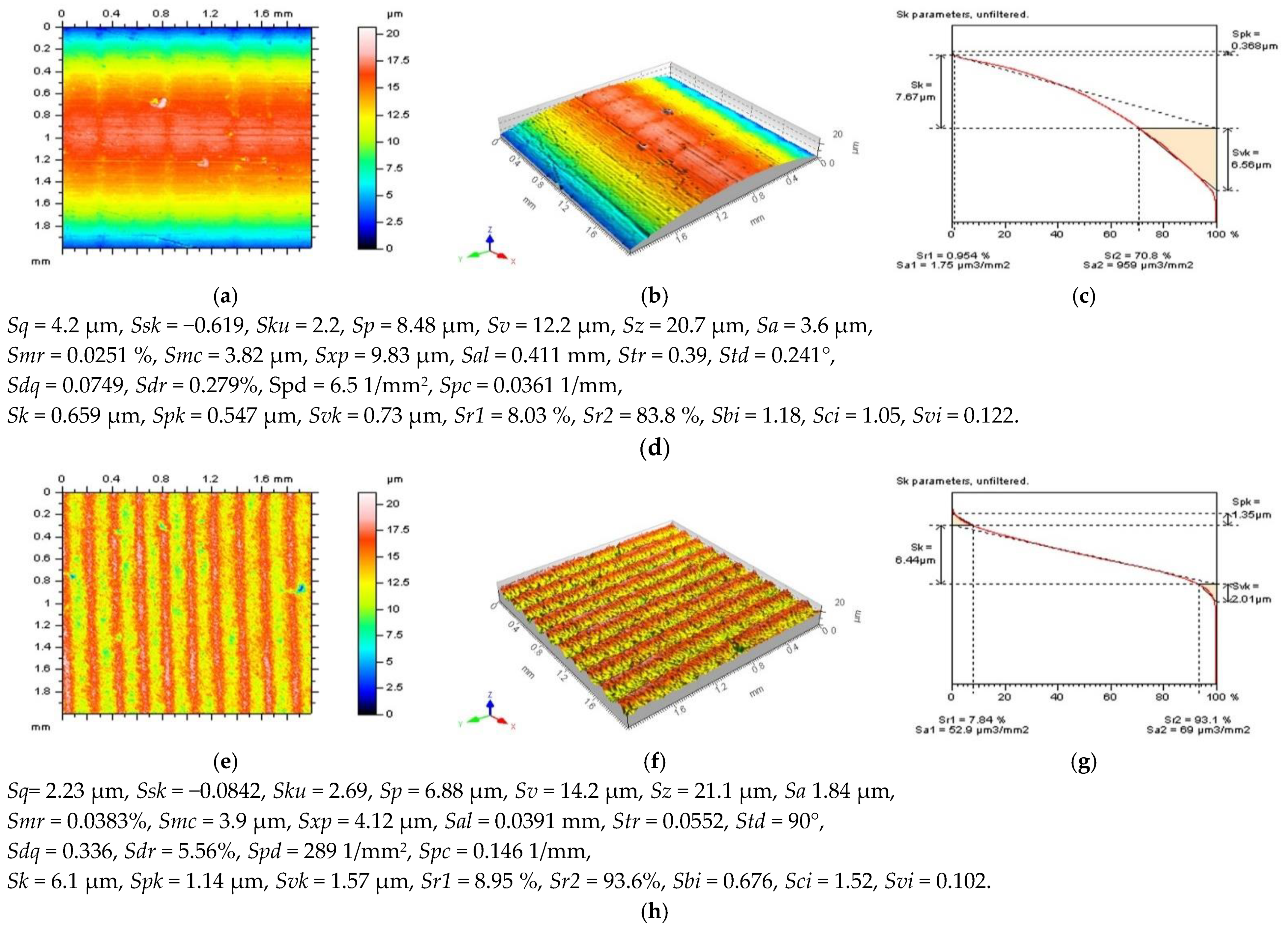

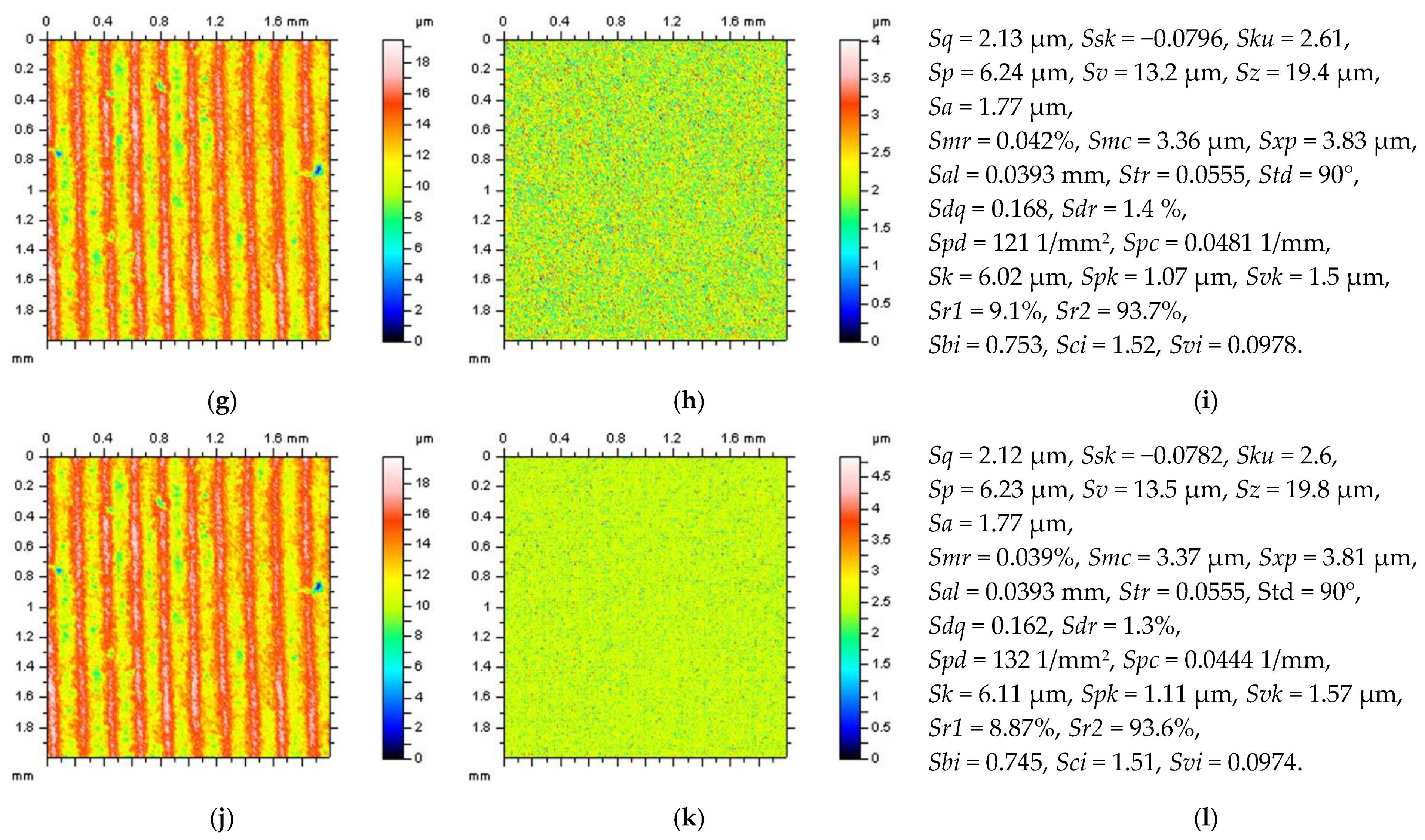


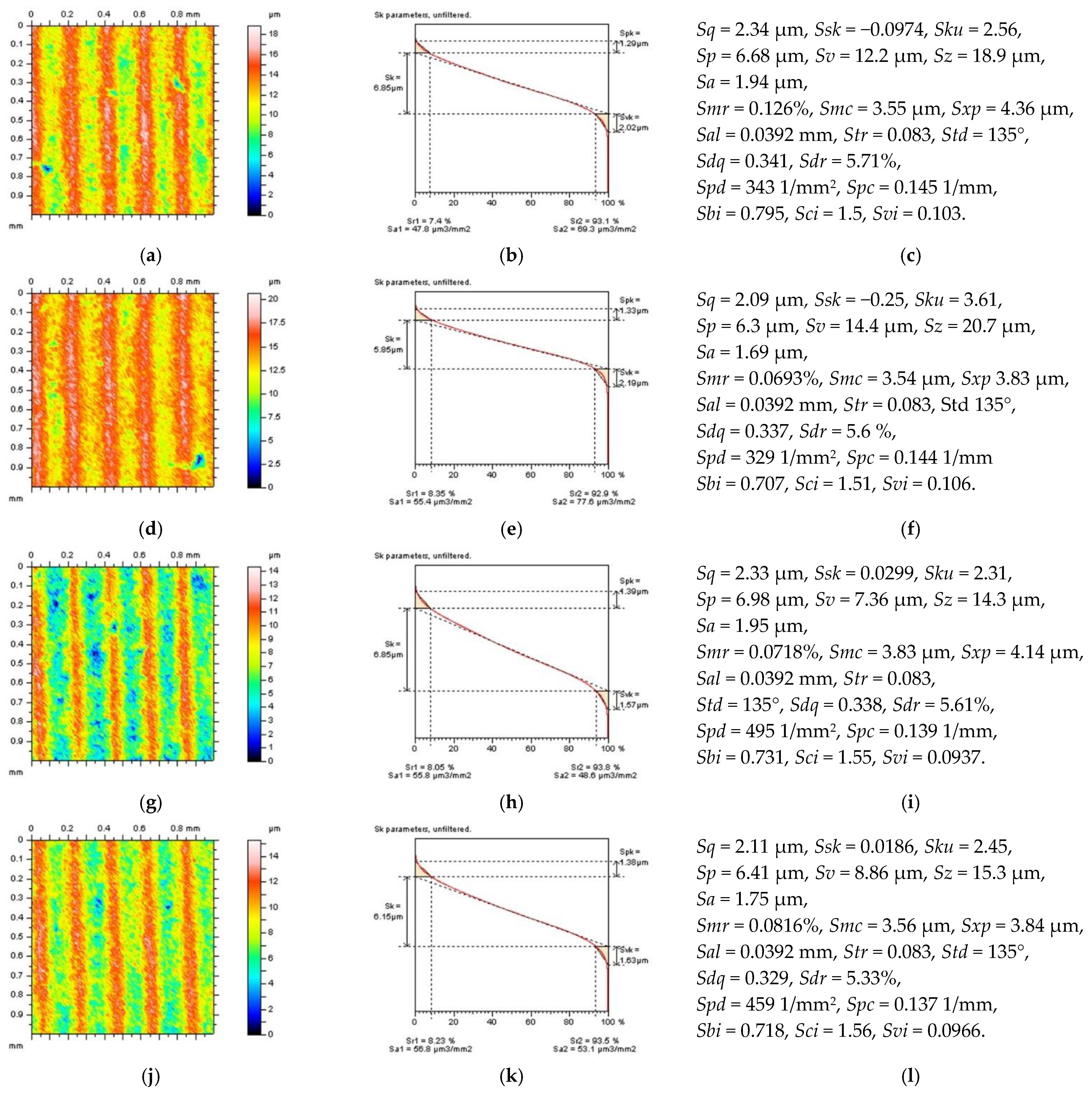
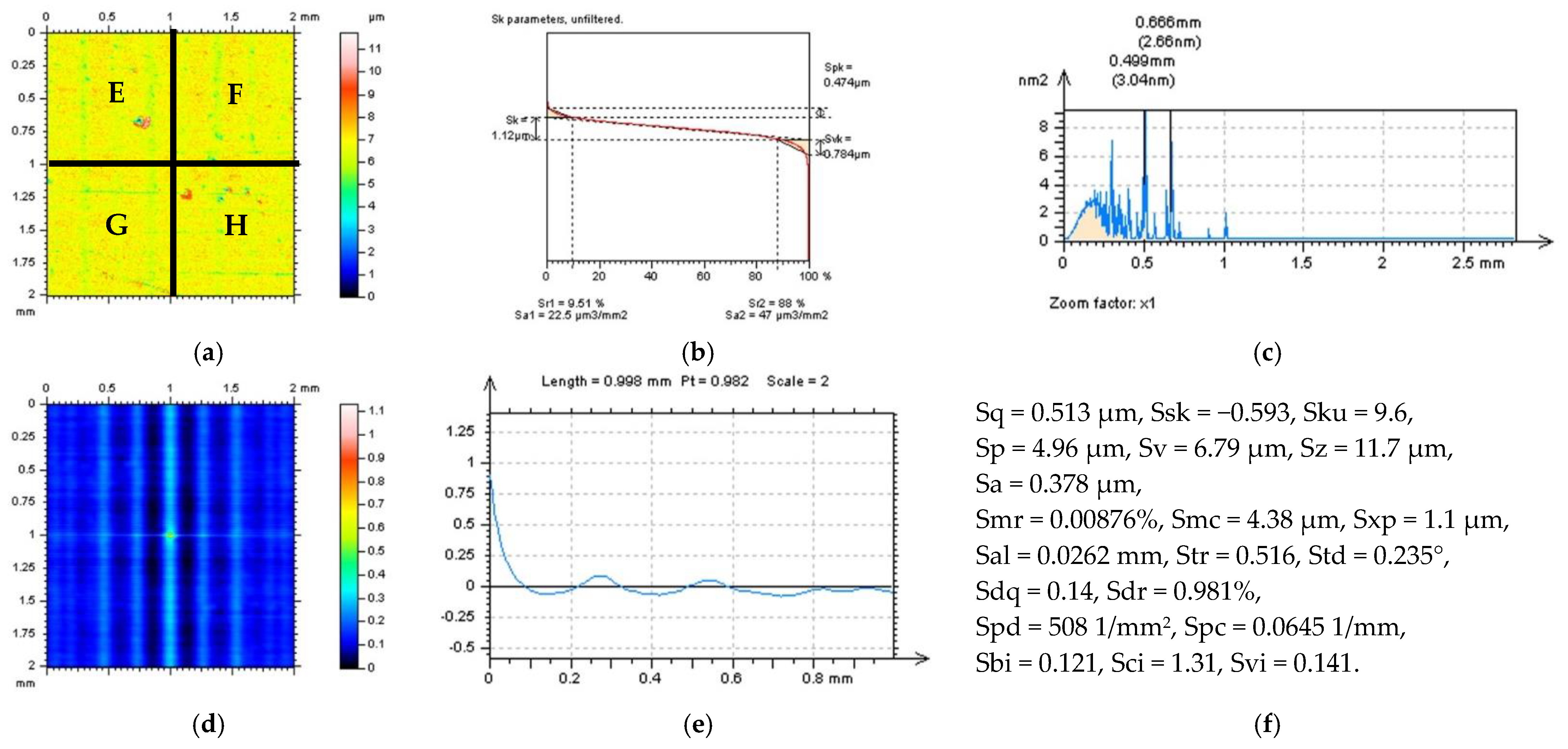
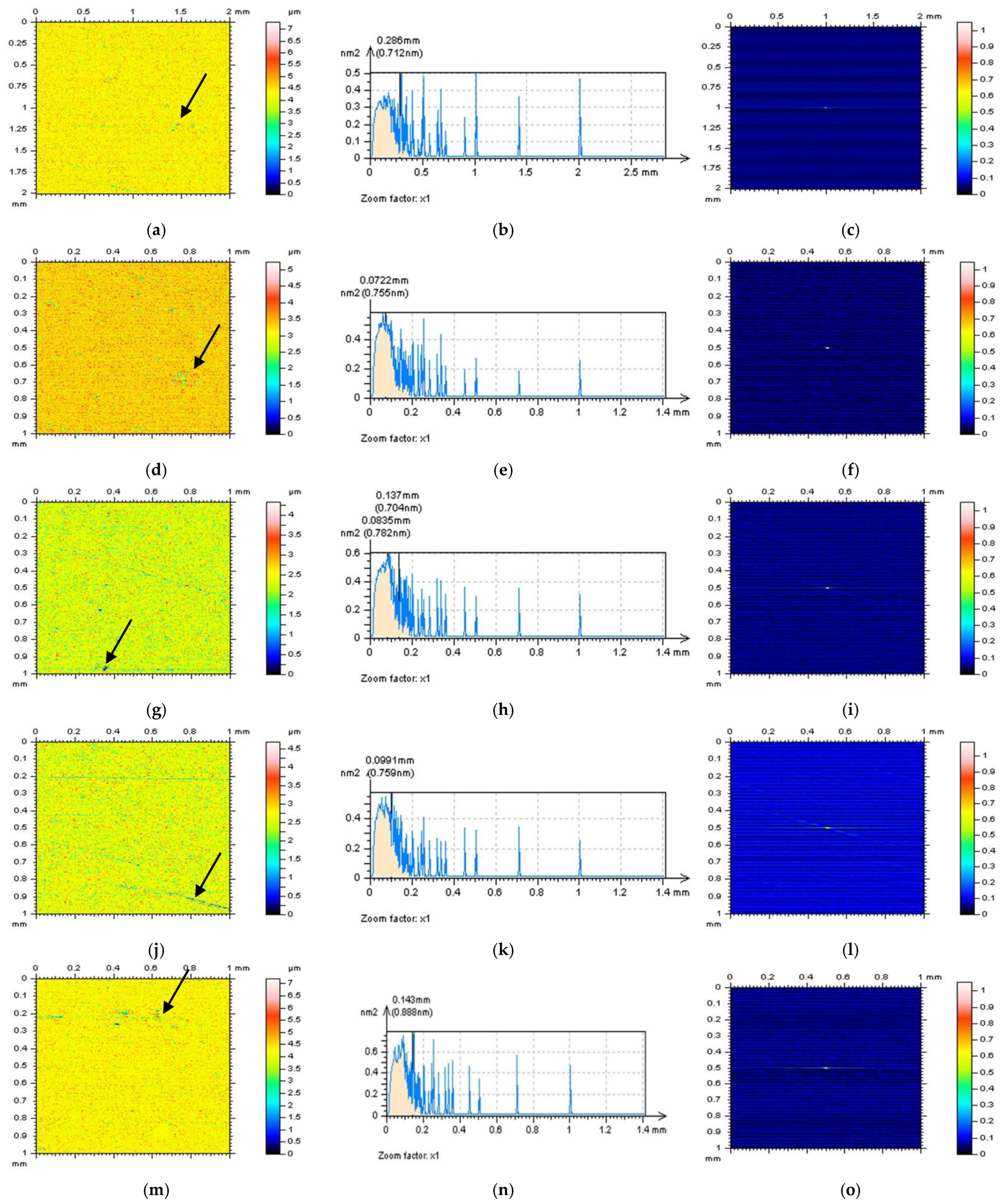
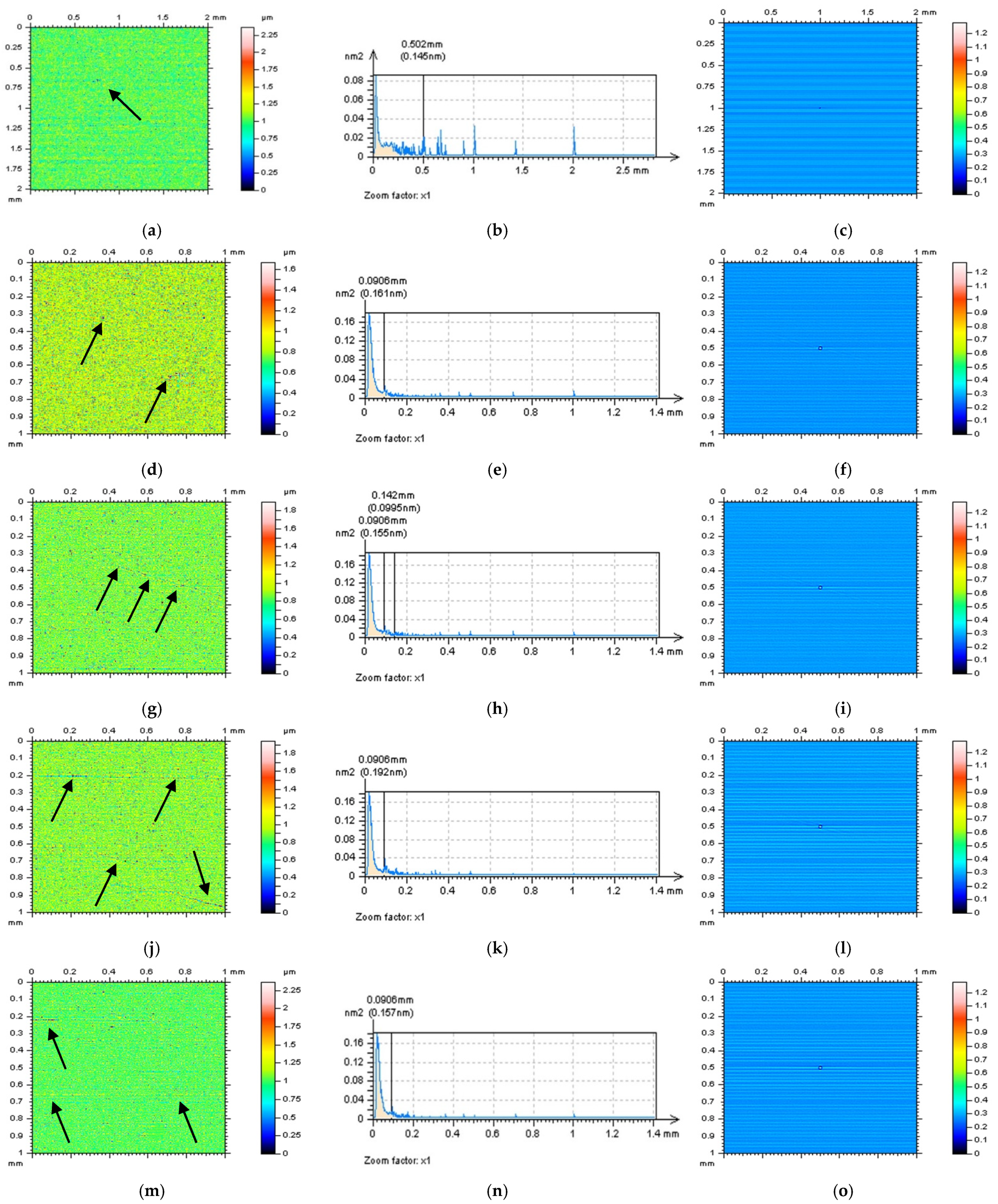
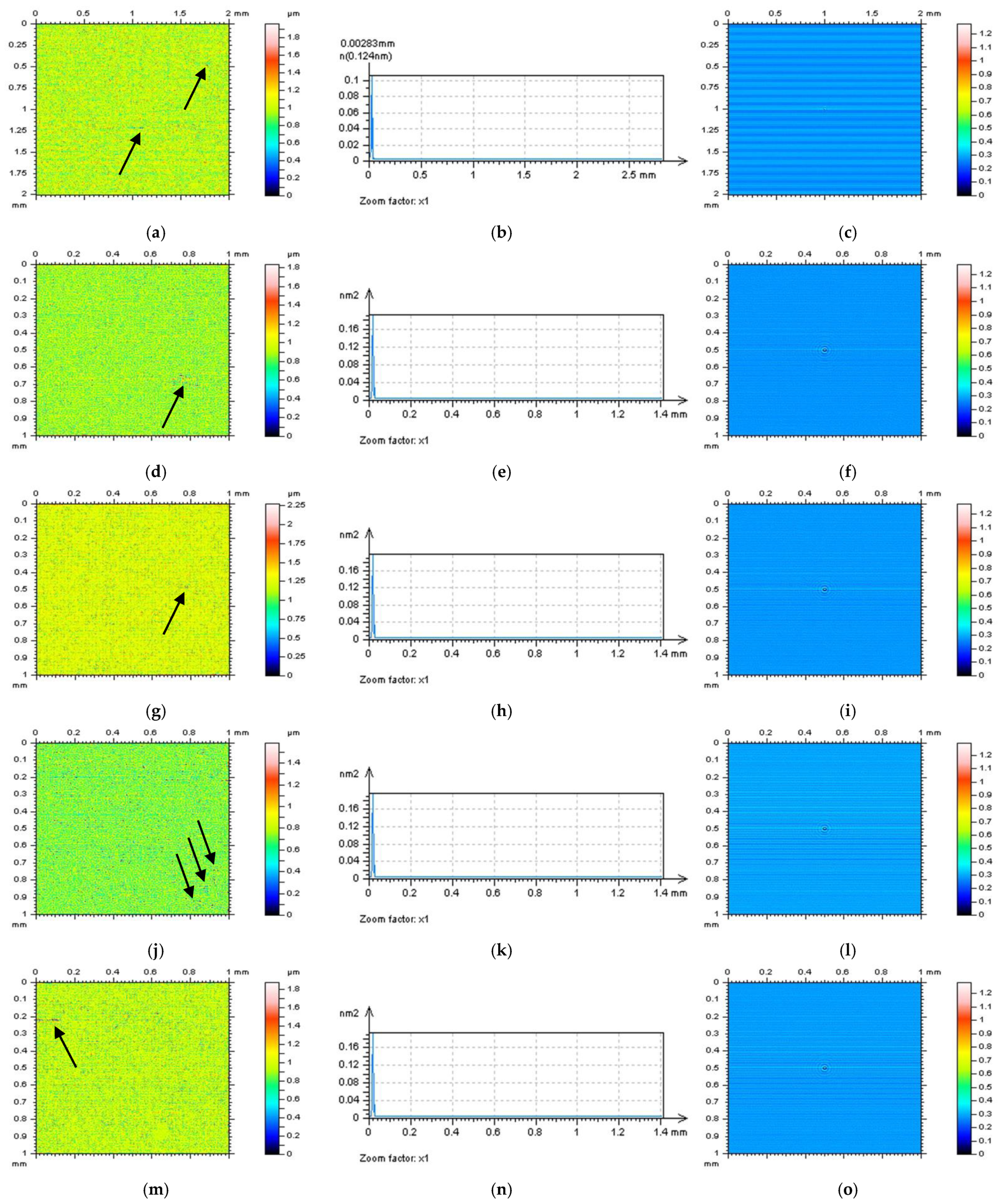

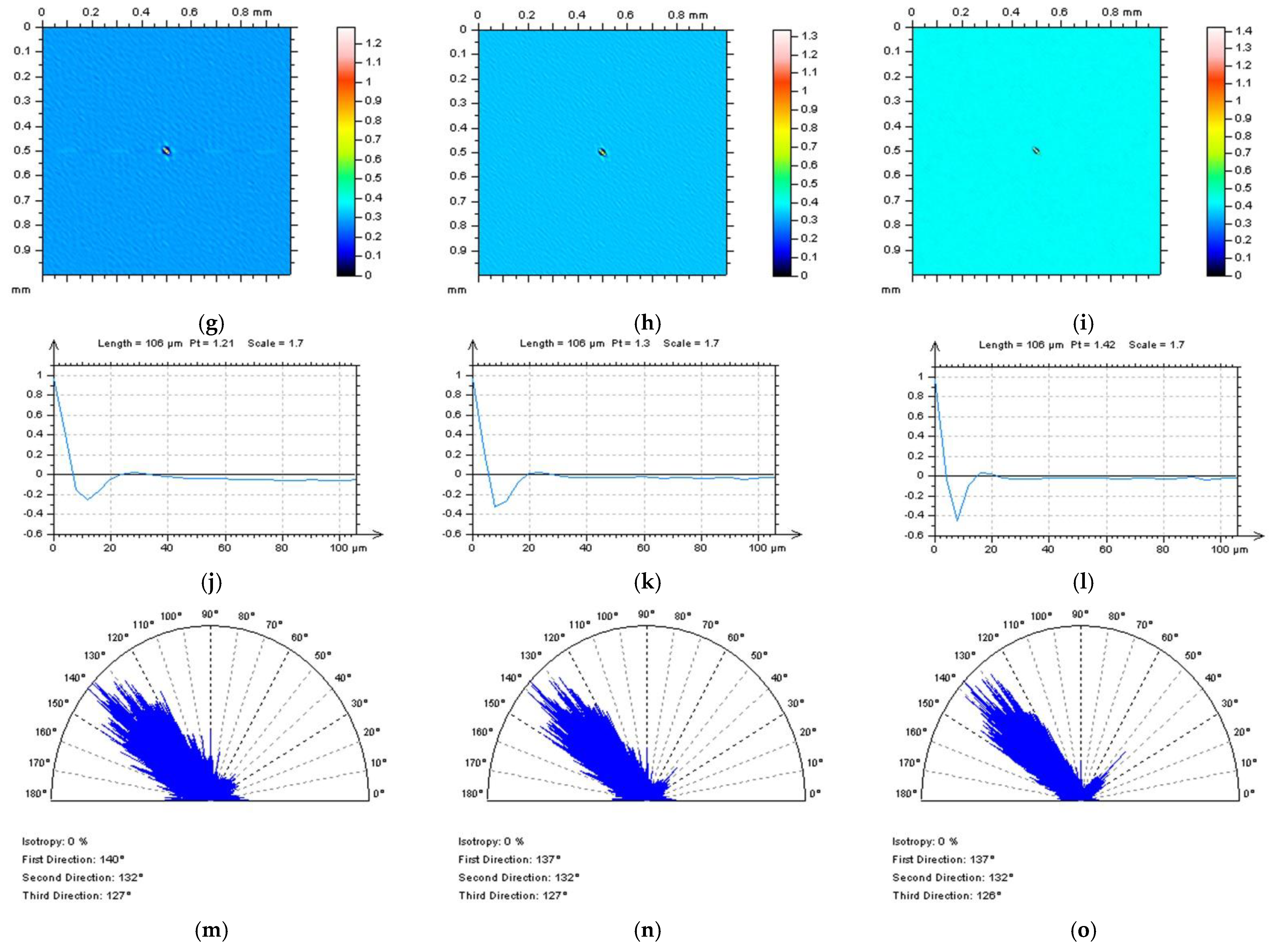
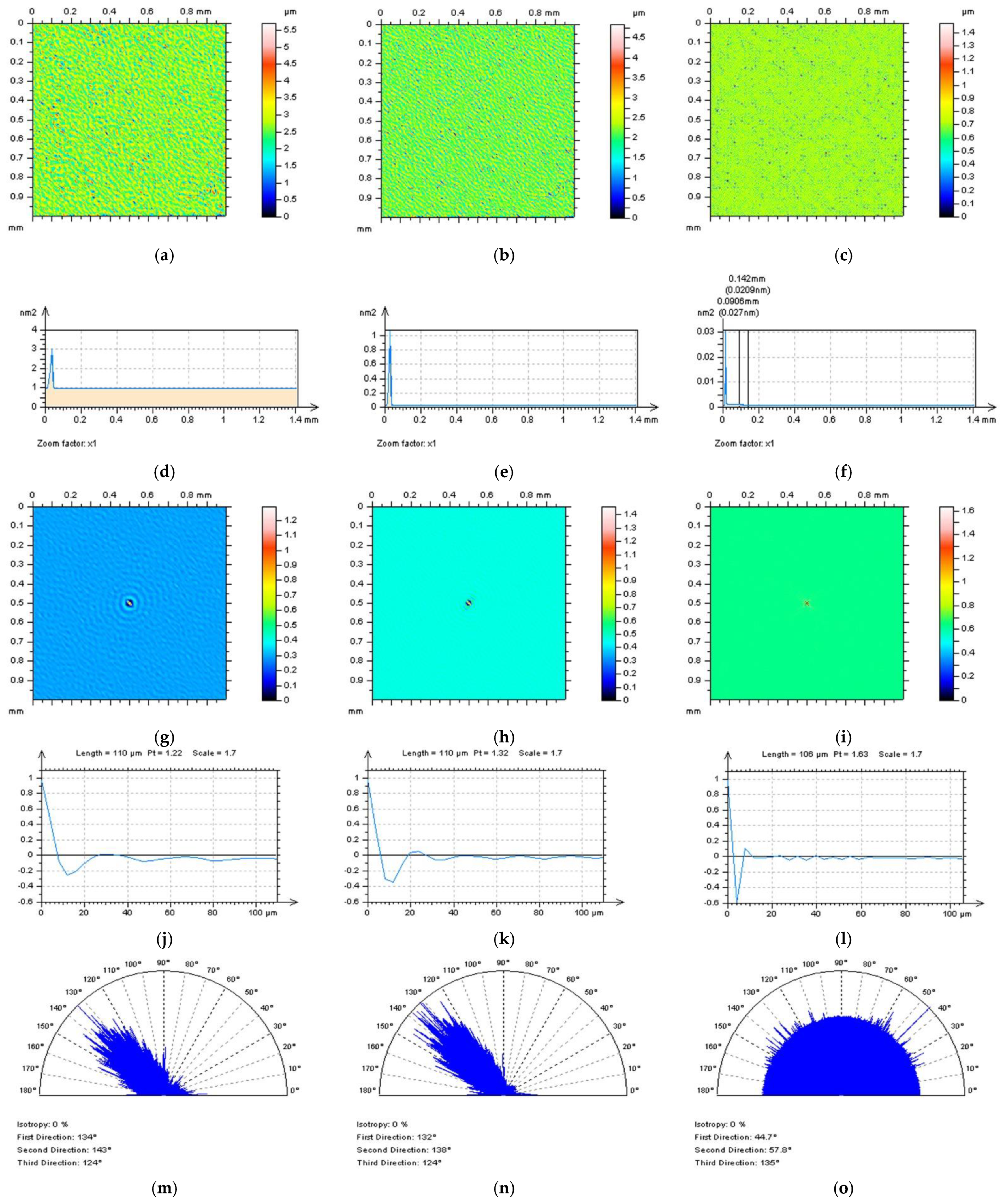
Publisher’s Note: MDPI stays neutral with regard to jurisdictional claims in published maps and institutional affiliations. |
© 2022 by the author. Licensee MDPI, Basel, Switzerland. This article is an open access article distributed under the terms and conditions of the Creative Commons Attribution (CC BY) license (https://creativecommons.org/licenses/by/4.0/).
Share and Cite
Podulka, P. Feature-Based Characterisation of Turned Surface Topography with Suppression of High-Frequency Measurement Errors. Sensors 2022, 22, 9622. https://doi.org/10.3390/s22249622
Podulka P. Feature-Based Characterisation of Turned Surface Topography with Suppression of High-Frequency Measurement Errors. Sensors. 2022; 22(24):9622. https://doi.org/10.3390/s22249622
Chicago/Turabian StylePodulka, Przemysław. 2022. "Feature-Based Characterisation of Turned Surface Topography with Suppression of High-Frequency Measurement Errors" Sensors 22, no. 24: 9622. https://doi.org/10.3390/s22249622
APA StylePodulka, P. (2022). Feature-Based Characterisation of Turned Surface Topography with Suppression of High-Frequency Measurement Errors. Sensors, 22(24), 9622. https://doi.org/10.3390/s22249622






